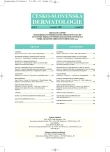Leg Ulcer and Thrombophilia
Ulcus cruris a trombofilná diatéza
Kazuistika prezentuje pacienta s desaťročnou anamnézou súčasne vyskytujúceho sa ľavostranného chronického posttrombotického syndromu s kožnými trofickými změnami na dolných končatinách-ulceráciami, ako aj s obrazom periférnej arteriálnej aterosklerózy na oboch dolných končatinách s hemodynamicky významnými stenózami. Molekulárně genetické vyšetrenie odhalilo mutáciu D/D v angiotenzín konvertujúcom enzyme (ACE), fyziologický genotyp apoE 3/2. Pacient je heterozygót v troch trombofilných génoch - v protrombíne, metyléntetrahydrofolát reduktáze (MTHFR) a v inhibitore I aktivátora plazminogénu (PAI), ktoré zohrávajú dóležitú úlohu v patogenéze ochorenia. Možno předpokládat', že rozhodujúcu úlohu v patogenéze klinického obrazu choroby zohráva vystupňovaná trombofília, ktorá je určovaná přítomnostem klinicky významných polymorfizmov troch trombofilných génov. Předpokládá sa, že etiopatogeneticky najvýznamnější je narušený proces kontinuálnej fibrinolýzy pri interakcii génov ACE a PAI-I, ktoré boli stanovené v patologických genotypoch. Zdórazňuje sa teamová spolupráca dermatológa, angiológa, kardiológa a hematologa, podložená kvalitnou laboratórnou diagnostikou, ktorá umožňuje vyššie etiopatogeneticky podložené liečebné efekty.
Klíčová slova:
hereditárny trombofilný stav - 5 génov: protrombínu, MTHFR (metyléntetrahydrofolát reduktázy), PAI-I (plazminogén aktivátora inhibítora I), ACE (angiotenzín konvertujúceho enzymu) a apo E (apolipoproteínu E) – ulcerácie na dolných končatinách – periférna arteriálna choroba
Authors:
K. Poljaková 1; R. Pullmann 2
Authors‘ workplace:
Kožná ambulancia Vrútky
1; Ústav klinickej biochémie, JLF UK Martin
2
Published in:
Čes-slov Derm, 82, 2007, No. 6, p. 340-344
Category:
Case Reports
Overview
The case report presents a patient with 10-year history of simultaneous chronic postthrombotic syndrome of the left leg with ulcerations and peripheral arterial atherosclerosis with haemodynamically important stenosis on both lower legs. Molecular genetic examination revealed mutation D/D in angiotensin converting enzyme (ACE); physiological genotype apolipoprotein E: apoE 3/2. Patient was heterozygous in three thrombophilic genes: prothrombin, methylenetetrahydrofolate reductase and plasminogen activator inhibitor I (PAI-I) which play important role in the pathogenesis of the disease. We might suppose that increased thrombophilic status determined by the presence of clinically important polymorphisms of three thrombofilic genes plays the decisive role in the pathogenesis of clinical picture. Supposedly the disruption of continual fibrinolysis due to interaction between genes ACE and PAI-I which were determined in pathological genotypes is the most important etiopathogenetically. The team-work of dermatologist, angiologist, cardiologist and haematologist with advanced laboratory diagnostics enables better etiopathogenetically based therapeutic approaches.
Key words:
inherited thrombophilic status – 5 genes: prothrombin, MTHFR (methyleneterahydrofolate reductase), PAI-I (plasminogen activator inhibitor I), ACE (angiotensin converting enzyme) and apo E (apolipoprotein E) – leg ulcer – peripheral arterial disease
Labels
Dermatology & STDs Paediatric dermatology & STDsArticle was published in
Czech-Slovak Dermatology

2007 Issue 6
Most read in this issue
- Galenic Difficulties in Incorporation of Urea into Topical Semi-Solid Vehicles Used in Compounded Prescriptions
- Atopic Eczema and Environmental Factors Adversely Influencing its Cours
- Dermatology in Transplantation Medicine
- Leg Ulcer and Thrombophilia
